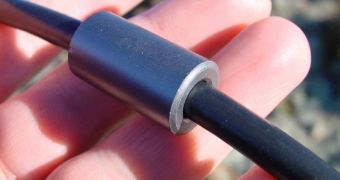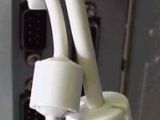I'm certain that most of the people reading this article have noticed at some point in time that some of the cables connecting the peripherals to a personal computer have some strange looking 'bumps' (see lower image). If you did, then you might have also asked yourselves what those things are and what role they have. These 'bumps' are also called chokes, or inductors with high reactance in certain frequencies of the electromagnetic spectrum.
They are mostly known as ferrite chokes (in this particular application), and basically consist of a cylinder made of a semi-magnetic material called ferrite that is slipped over the cable during the fabrication process. Ferrite is generally brittle and can easily break when subjected to physical shock; due to this reason and for esthetic considerations, the cylinder is usually encased in plastic, hiding away from view any clue to what the 'bump' might contain.
Ferrite chokes have the role of reducing electromagnetic inferences produced or received by a particular electronic device. During operation they depend on a property known as self-inductance, isolating the alternating component of the electric current while direct current signals are allowed to pass through the cable without restrictions.
As you probably already know, during operation a personal computer generates several electrical signals with frequencies ranging from 300 to 1,000 MHz. These can easily produce radio signals at the respective frequency. Because the different cables connecting to the computer basically act as antennae, the produced radio waves could potentially be broadcast into the surrounding medium, where they interfere with the correct operation of other electronic devices.
In order to prevent this, ferrite chokes are used. As an alternating component passes through the cable it will eventually encounter the choke, where the magnetic field produced by the flowing current induces a magnetic flux in the ferrite material, which in turn generates an electromotive force opposite to the charge of the current. This basically 'chokes' the radio frequencies and prevents them from escaping into the medium.

 14 DAY TRIAL //
14 DAY TRIAL // 
